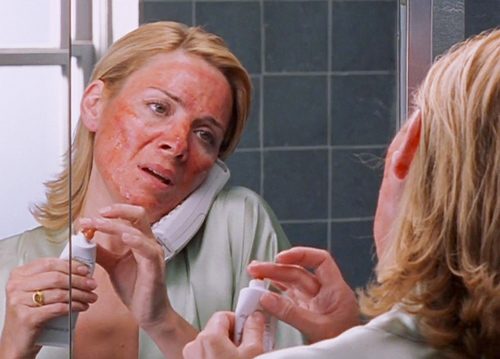How well do you prepare your clients for treatments such as laser, injectables or so-called Vampire Facials?
Not just things like applying topical numbing agents or local anaesthetic injections, or prepping their skin with cleanser, exfoliant, toner and, if required, a sanitising agent – how do you manage their expectations well before they enter the treatment room?
Popular Melbourne TV and radio presenter, blogger and well known AFL WAG Bec Judd (above) turned up to record her KIIS FM show this week with what she laughingly described as “a face for radio”.
Or, as her co-host Monty described it, a face that looked like it had “been blasted with a torch of fire”.
Late last week, Bec had a fractional laser treatment that purports to fix everything from sunspots to wrinkles and pigmentation and generally blitz years off the face.
The aftermath of this particular treatment means Bec will be “going underground” for a week or so while her skin heals and the redness fades.
“I’m not doing any filming this week and you know that saying ‘You’ve got the face for radio’, that is me,” she laughed.
There’s little doubt Bec knew what she was in for as she regularly trials and reviews aesthetics treatments.
But the fact is, many people don’t. These anti-ageing miracle workers have become so accessible – dare we say commonplace – over the past decade that what they involve can be too easily underestimated. And you need to prepare them for possible eventualities, or it could backfire on you.

THE PAIN FACTOR
Many treatments are promoted as causing minimal to no pain/discomfort. But this can be very subjective according to individual clients.
Whereas one person might find a certain kind of laser or IPL treatment a breeze, another may have a low pain threshold.
How much pain or discomfort a client feels during a treatment can depend on many factors: fear of the unknown, underlying health issues, their overall state of mind – or they just naturally have a lower tolerance to pain.
Also, the skill and the experience of the therapist performing the treatment can come into play.
Ways to prepare your clients:
- Don’t tell them it won’t hurt. It may well not, but they’ll sure as hell blame you if it does! I have a good tolerance for pain after extensive, invasive dental work, but even I have been blindsided by some treatments. For instance, I have had both ultrasound and radiofrequency skin tightening over the years and, particularly when the device was applied to areas closest to bone, I nearly hit the roof. I wouldn’t have minded so much if I’d been mentally prepared to handle it, or it had been suggested I took painkillers before the treatment to take the edge off. Um, it’s a bit late when the deed is done and the treatment bed drenched with sweat that you’re told this would have been a good idea! I was thrilled with the eventual results, but just sayin’ …
- Do your research (a good starting point is with the company that has supplied the technology you are using) about whether you should suggest things to clients like taking a painkiller (or even a sedative, under a doctor’s guidance) beforehand.
- If you are in a position to offer it, have “happy gas” at the ready to relax a tense client during a treatment.
- Techniques like keeping up a line of banter during a treatment, giving the client a stress ball to squeeze, reminding them to breathe steadily or suggest they wiggle fingers and toes can all be great distractions from what they are feeling (or fear they might feel).
- Where appropriate, have ice packs at the ready to offset discomfort and reduce swelling.
- The pain/discomfort sometimes doesn’t stop when the treatment does; post-procedure healing can also cause distress as well as other side effects like swelling, redness and bruising. Make sure your clients are prepped to deal with this if it happens and ease the panic factor.
EXPLAIN DOWNTIME
A bit like the pain factor, everyone’s perception and experience of downtime can be different.
Let’s be honest, a person who has had a high energy laser treatment, as Bec Judd did, may not need to take to their bed for days to recover but they’re not exactly going to be able to party the night away – unless perhaps it’s a Halloween theme.
“They kind of torch you with this laser,” Bec told her radio co-host Monty, explaining that the skin goes bright red and will peel away to reveal fresher, younger-looking layers as it heals, a process that takes about a week.
She told her Instagram followers they definitely wouldn’t be getting a photo of her lasered face, but provided another image for comparison – the time Samantha got a chemical peel on Sex and the City.
Even with less invasive treatments, people can construe “downtime” to be very different things.

A couple of years ago I had full face (including upper and lower eyelids) and neck PRP, the so-called Vampire Facial.
It involves taking vials of the patient’s own blood and spinning it in a centrifuge to extract a growth factor-rich serum (platelet rich plasma) that is then reinjected to the desired treatment area(s) in a series of superficial injections to rejuvenate the skin and help lift sagging facial features. These days PRP can also be delivered to the skin via micro-needling.
I knew what to expect as I’m no novice to these treatments and the highly experienced nurse injector didn’t pull any punches.
So I didn’t blink an eye (albeit it would have been difficult anyway with my puffy post-treatment lids) when I looked at my grotesque visage in the mirror; something like a Halloween pumpkin.
My face and neck were bright red and extremely swollen, and I was advised not to put on any camouflage makeup on to disguise it.
I simply popped on sunglasses and walked to the station. I’d already forgotten about what I looked like when I stopped to buy a magazine, and took my sunglasses off. The horrified stares of fellow customers told me everything I needed to know about my appearance.
The swelling persisted for several days and by that time some pretty heavy bruising had set in that lasted nearly two weeks.
Because I was prepared and have no problem with people seeing me in “recovery” mode, it didn’t bother me (it sure bothered a lot of other people!!!), but imagine if a client wasn’t prepped for the aftermath …
Sometimes even treatments that normally don’t cause more than transient redness or swelling (eg. microdermabrasion, or low level lasers/IPLs) can cause unexpected side effects, such as sustained redness. Again, it’s an individual thing and should never be discounted or underestimated as a possibility.
TIMING IS EVERYTHING
How people respond to treatments and how rapidly they recover depends on factors like skin type and colouring, their age, lifestyle habits and overall how healthy they are.
A cosmetic physician once recounted to me (the horror still lingering) of a patient who’d presented for “the works” with dermal fillers on her face in preparation for her daughter’s wedding.
After revolumising her cheeks and augmenting her lips, refining the jawline, filling naso-labial grooves and marionette lines from corners of the mouth to chin, and smoothing lines on the forehead and around the eyes with Botox, the doctor asked when the wedding was.
“Tomorrow morning!” the patient excitedly exclaimed.
Dr X nearly fainted. Of course this patient was going to be swollen and likely bruised by the morning, and possibly for days afterward.
I don’t remember how, or if, this crisis was satisfactorily resolved but the lesson is – when a client or patient books for a treatment that will result in several days of such side effects, make sure you ask them if they have any special occasions looming or other reasons where they don’t want to be seen looking like they’ve walked into a door!




